
Plumes of spray shoot up where waves strike the rocky spires of a reef off the coast of Guna Yala. Totem is bashing west to our next pocket of protection for anchoring, and none of our charts on board match what our eyeballs tell us. “I guess we won’t sail between those islands” considered Jamie while eyeing breakers that stretched across the gap. One chart showed the area as grayed-out UNSURVEYED territory. Two others with some detail suggested it was passable. Welcome to navigating in the eastern Guna Yala! (This post builds on the prior introduction to Guna Yala).
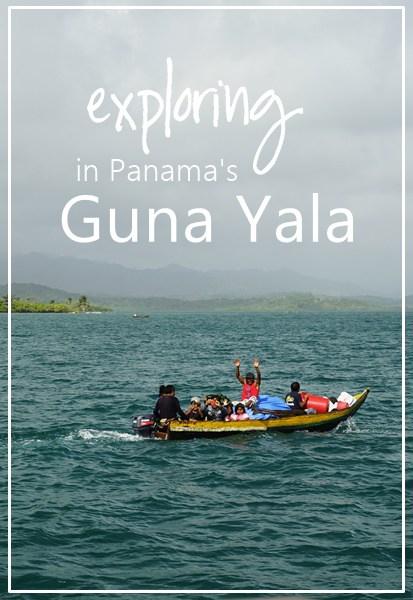
Visitors arrive paddling a large dugout ulu (which also sports a 9.9 hp outboard) from the cane-and-thatch homes nearby. Three generations of a family come aboard: grandmother, parents, and three young children. Together they comprise the majority of the 11-count human population of this community, a handful of structures built a few yards over the water on piles of coral rubble.
Arsesio speaks reasonable English, a legacy of the time he spent in Panama City before choosing to return to traditional Guna life. A few of our Spanish words come in handy too; his wife and mother are more reserved but listen in and smile at appropriate enough times that I think they understand more than they let on. We share snacks stories of our lives while his adorable toddler stuffs crackers into the top of a winch, just like our own kids found them receptacles perfectly suited as string cheese holders some a few years ago. Gifts were lightly bartered: green coconuts and plantains in thanks for batteries and candles. (I’d love to come back to Guna Yala with cases of solar-powered Luci lights to brighten evenings in settlements like this!)
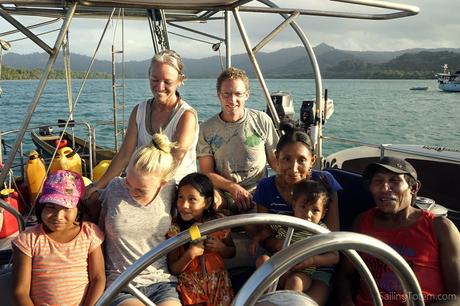
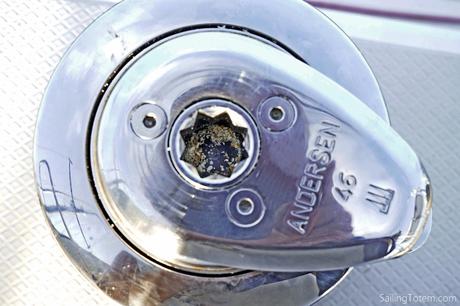
He later asked a favor: since we were headed west, could we take his family (his mother Selina, wife Obaldina, and their three children) on Totem to their larger island community? We pored over the thin data on our charts, and it looked risky. The shallow draft of their dugout makes it effortlessly through a channel between islands and mainland, but it looked questionable for Totem. In good conditions, with water depths we could visually pilot? Maybe. But whitewater blowing across the reef didn’t give us enough to work with for finding a safe path.
Meanwhile, learning about the reason for the request helped us understand how to help. It was time to fill their canoe with coconuts, plantains, and more to sell at the densely populated 10 miles north. Yet when it was loaded down (this included two additional village members, their gear, and an intact but very much not alive deer-like mammal), the sea state was too rough to safely cross the ocean pass between the islands. Now we knew what to do: it was a matter of getting them across this cut into the lee of the next island, not all the way up to their destination; and that we could do. And so, the following morning, all six family members boarded. It wasn’t until they began loading goods—a chain saw, a portable generator, a shotgun, a plastic tub of clothing, two puppies!—that the need became even more apparent. No way could they get across the rough seas in their dugout with all this! So our girls led their girls in coloring pictures below deck while we nibbled fresh bread in the cockpit with adults. It wasn’t a long journey, but an unforgettable one.
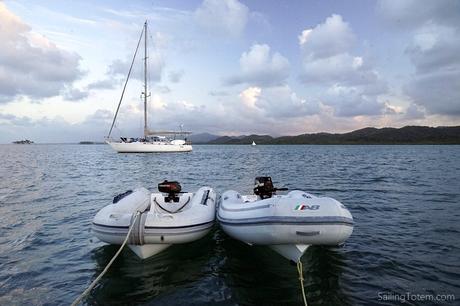
We had all the company we needed already with Utopia II.
The eastern range of Guna Yala (also called Kuna Yala, or San Blas) is virtually devoid of other cruising boats: we encountered only one throughout this stretch. Did the relative isolation foster opportunities like meeting the family in Escoses? On another island, we were shown ambergris worth tens of thousands of dollars sitting out on a coral wall to dry. Near Playon Chico, a frequent Guna visitor would ramble for hours some afternoons on everything from his island’s upcoming chicha festival to bandidos stealing from his garden on the mainland. There’s the time our guide for a hike told us with pride about the role of US military in supporting Guna independence; he offered geologic survey markers from the late 1940s as evidence and told us about the armadas from the US to support the Guna during their struggle for recognition – pointing to his ballcap commemorating the 90th anniversary, 1925-2015. And memorably, the afternoon a weathered man beckoned from his doorway calling “cultura! cultura!”- culture, my kryptonite – to show me rows of nuchu, statues with living spirits important to Guna religion, on a corner hutch inside his drafty bungalow.

In the western San Blas, the dynamic shifted significantly. Here were scores of cruising boats. Not all islands follow the Guna’s traditional ways. There were conveniences again: the ability to buy bread and other groceries from small stores (in the east, fewer options and smaller shops; we might buy coconuts or plantains or fish from an individual with extra). Internet access. And here, at last, were the breathtaking islands: white sand beaches, tall coconut palms leaning gently towards turquoise water.
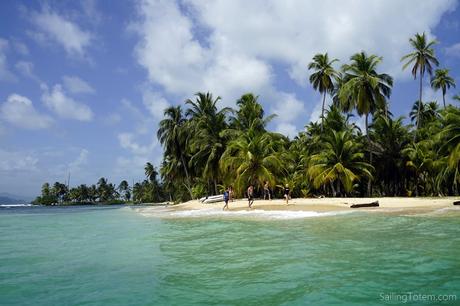
Empty anchorages of the east were traded for bays holding a dozen or more boats at a time. Many were long-term liveaboards, many were “backpacker boats” ferrying travelers (at surprising cost) for their Kuna Yala Experience… or an alternate mode of transportation to Colombia. A few, like us, were cruisers passing through; the western islands are an accessible overnight sail away from the canal region.
These numbers shift local dynamics. Guna in the western islands have built livelihoods around marketing to visiting boats. Dugouts were more likely to come along side marketing handicrafts, offering tours, selling fish and lobster, and occasionally other provisions. And here in the west, thanks in part to that reach, are renowned mola makers: Venancio Restrepo, from Isla Maquina, and “Mola Lisa,” from Rio Sidra.
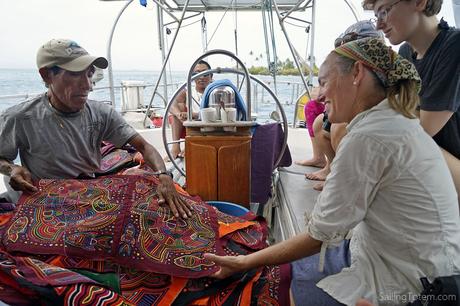
Venancio and his brother Idelfonso charmed us with their beautiful textiles, patient explanations, and gentle manner
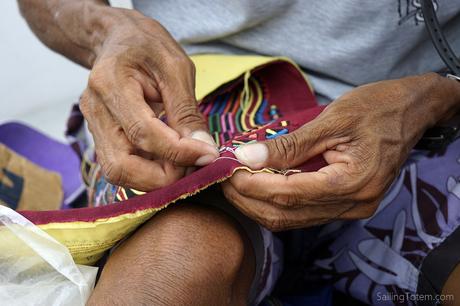
We saw stunning molas in the east, too, but the combination of volume here, the English proficiency of the artists, and their ability to range to the more distant islands favored by cruising boats contribute to their fame.
Shortly before we departed San Blas, a Guna family from Nusatupu island (just below Rio Sidra; near 9 26.8 N / 78 50.20 W ) sailed their ulu over for an early morning visit. They’d seen our mast over the spit of mangrove-covered land that separated us from their home. Igua and his parents were pleasant company; his mother, Floricelda, more outgoing than any other Guna women I met. They visited in our cockpit for a while—drinking coffee, offering molas for sale. From them we learned about the divide is then between Guna who can afford outboards for their canoes range further from the settlement islands to peddle molas; should we return (I hope we return!), I’d make more of an effort to seek out these islands and the artists who don’t have those means. Igua is an albino; there’s a high incidence of this among Guna. The trait is revered, and has a special place in their culture, but given the hot tropical sun… we sent Igua with a bottle of sunscreen. I wish I could say if I’d though tof it first, but it took his request for an application from the one in our cockpit for me to clue in. Maybe some boat in our wake can stop in at Nusatupu, pass along a bottle of sunscreen for Igua, and tell Floricelda her beautiful mola has a good home.
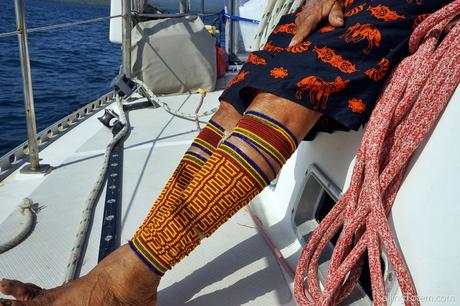
Floricelda allowed photo of her stunning wini, the beadwork decorating women’s arms and legs
Guna Yala holds so many facets of what makes our life interesting packed into one place. Picture-postcard views when the sun emerges (white sand, turquoise water, islands the size of a baseball field sprinkled with palms). Deserted islands where the kids can swim and play. Low tech local community, where people have time to talk. Cultural experiences far from our norm, with lessons to give. And not least, good company: this is the last sailing we’ll do with Utopia II for a while, and so we made the most of it.
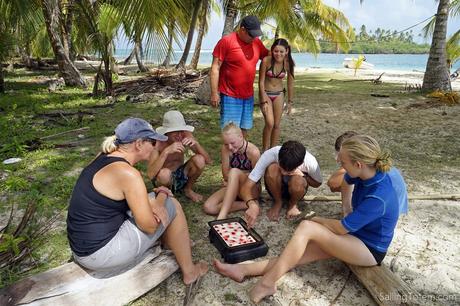
Celebrating a boat-kid-birthday in typical low key style, with a beach picnic and games.
Next: practicalities for cruisers planning to sail for Guna Yala / Kuna Yala / San Blas

